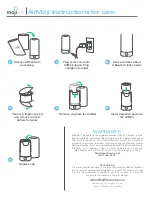
User guideline NORTEC sonic
NRSB-09
Issued by: PM Floor Division
10.6.09
Page 5 of 6
Rev.00
NRBS-09
textile coverings. The panels are therefore labelled with an arrow. In addition, it has to be
checked whether they fit well and only then the next panel can be inserted.
3
Substructure
No pedestals, stringers, bridgings or other substructures may be altered. If in exceptional
circumstances, such as for subsequent installations, it becomes necessary to dismantle
any components, then the raised floor system may not be loaded. Non-compliance might
result in the danger of a collapse of the system! System components which have been
dismantled have to be remounted when the work is completed so that the vertical load
removal and the horizontal rigidity are again assured.
4
Cable installation
Do not draw in cables over the edge of the floor system or a panel. Do not pull off or
damage pedestals through overstraining with the installation of cables in the cavity. Good
idea: Lay cables in from the roll.
5
Protective measures
5.1 Extraordinary loading
The floor has to be covered with planks, chipboards or steel plates with the transport of
heavy loads. The floor covering and the gluing is protected this way and the loads are
distributed to a larger area on the floor system.
Dynamic loads from lifting carts, forklifts etc. may not be included in calculations by simply
transferring the wheel loads to static loads. In such cases the DIN 1055 as well as the
maximum permissible loads of our raised flooring systems have to be observed.
The tests and the classification are made according to current standards. The permissible
load indention points are defined in the application guideline to the DIN EN 12 825.
















